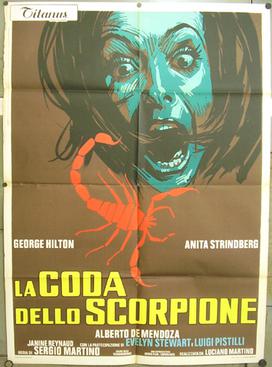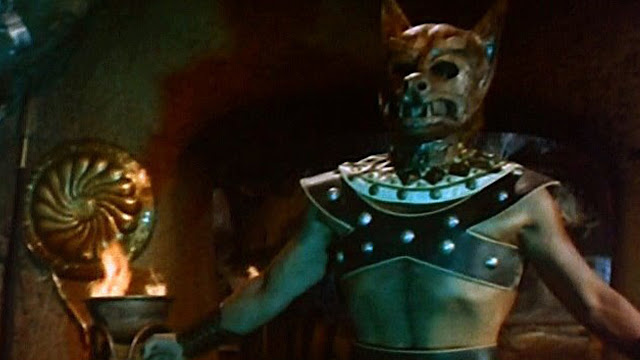PHENOMENALITY: (1,3) *naturalistic,* (2,4) *uncanny*
MYTHICITY: (1-3) *poor,* (4) *good*
FRYEAN MYTHOS: *drama*
CAMPBELLIAN FUNCTIONS: *psychological, sociological*
*SPOILERS SPOILERS SPOILERS*
Due to my regard for Carroll Baker, who turned her back on Hollywood to seek her own path in Italian cinema, I wanted to like all of these stylishly-directed thrillers, four quasi-giallos which Umberto Lenzi directed with Baker as the star. But only one of the four proved itself worthy of the talent involved.
PARANOIA was the title by which the Italian film ORGASMO became known in the U.S. Baker plays Kathryn, a wealthy widow who tries to start a new life by moving into a villa in Italy. Though she's surrounded by caring protectors, her boredom leads her to take up with a younger-by-ten-years fellow named Peter. After Peter worms his way into the bored woman's bed, he not only slowly begins to get rid of the villa's servants, he also brings in his beloved sister Eva to stay there. Peter even convinces Kathryn to undertake a threesome, but later the widow is deeply shocked to learn that her two guests are only step-siblings and therefore have no compunction against having sex without her. As soon as Kathryn asks her guests to leave, she learns that they hold all the power over her, and that her carelessness has led to her doom. The downbeat conclusion of this thriller comes close to registering as an irony, but I rate it a drama since on some level Kathryn never completely succumbs to the degradation of her predators.
Though the sex-scenes of PARANOIA would be fairly tame today, they engendered enough controversy that Lenzi and Co. quickly followed up with the same-year SO SWEET, SO PERVERSE. In contrast to PARANOIA, though, the sexual content of SWEET is mostly implied, perhaps because its basic plot is borrowed from the novel and film DIABOLIQUE. Industrialist Jean (Jean-Louis Trintignant) is on the outs with his wife Danielle (Erika Blanc), but as it happens he's put in the position of becoming a savior to Nicole (Baker), who is being abused by her husband Klaus. Nicole rewards Jean by taking him as her lover, all the while complaining about what a weak vessel she is. This turns out to be a dodge, for in truth Nicole is a cold hearted master planner who's conspiring with both Klaus and Danielle to knock off Jean. The trio succeed, and it seems like Danielle and Nicole will enjoy some lesbian action from then on (though nothing is shown on screen). But like the passive female character of DIABOLIQUE, Danielle is haunted by the fear that Jean may still be alive. It's not much of a "phantasmal figuration," amounting to nothing more than a few ambiguous phrases from Nicole, but Danielle's guilt puts her in the position to be the next victim. A final coda suggests that the evil plotters won't get away with it despite their cleverness.
A QUIET PLACE TO KILL-- which was titled PARANOIA in Italy, possibly as an inside joke by Lenzi-- also borrowed from DIABOLIQUE to an extent, but stayed staunchly in the realm of the naturalistic. Helen (Baker) is a race-car driver (!) who flips out and goes on vacation. Her ex-husband Maurice (Jean Sorel), married to Constance (Anna Proclemer), invites Helen to a party at his residence, and once there, Helen and Constance find that they're got a mutual disgust for Maurice. As in the opening scenes of DIABOLIQUE, the two women plot to murder the man who has mistreated them both. However, the murder attempt goes wrong, and Constance dies. Their mutual guilt leads Helen and her ex to cover up the death and to be forced together (which at least leads to a lot better sex-scenes than we got in SO SWEET). However, Susan (Marina Coffa), the adult daughter of Constance, shows up, determined to learn the truth behind her mother's death. She disgusts Helen by sleeping with her stepfather, but later, Maurice also apparently perishes. Suffice to say that at least this script spices things up by introducing a second conspiratorial couple as a contrast to the first one. But aside from the sex-scenes and some nice camera-work, the film drags its way to a contrived conclusion.
KNIFE OF ICE, the last Lenzi-Baker collab, displays more promise than the previous three films. Martha (Baker) is a woman who lives with her uncle Ralph at an estate in the Spanish Pyrenees. During her childhood Martha witnessed her parents' death in a train accident, and as a result she became mute, partly because her parents died after throwing Martha clear of the accident. Despite that trauma, the movie starts off showing Martha transcending her trauma by meeting her cousin Jenny (Evelyn Stewart) at a train-station. Martha and Jenny are driven back to the estate by Martha's somewhat creepy chauffeur Marcos (Eduardo Fajardo), but when Marcos has to leave the car briefly, a strange man peers into the car at the two women, and then vanishes into the Spanish fog.
At the estate creepiness becomes more exaggerated as Jenny gives her uncle a present of occult books, while Martha continues to have occasional flashbacks to the tragedy, indicating that her struggle is far from over. A small ensemble of characters assemble at the estate in order to welcome the visitor, and though none are overtly weird, Lenzi keeps the proceedings just slightly off-kilter, in which the things people say suggest other meanings.
Then Jenny is knifed to death by a black-gloved killer whose face, naturally, the audience does not see. The police question all the residents and employees, and assert that another female victim was recently killed in the area, causing them to suspect a sexual deviate. The occultist uncle goes further, hypothesizing that the killer may be a Satanist, who slays innocent women due to their symbolic equation to Mary, Mother of Jesus, so that the murder-victims are as Satanic sacrifices. An additional odd touch: twice Martha flashes back to a bullfight she witnessed prior to her malady, and one flashback shows her taking pleasure in the violence.
Other minutiae multiply. A card with a Satanic sigil comes to Uncle Ralph in the mail, and the weird guy is seen stalking around the city. Martha considers leaving the estate to avoid the maniac, but of course events contrive to keep her close to the mystery. The cops catch the weird guy, who admits to being a Satanist but not to being the killer. More victims die, including (maybe) Uncle Ralph-- or is that a deception to catch the killer?
Of all four Baker-Lenzi works, KNIFE is the only one that has a strong psychological concept underlying it. Other authors were credited with the scripts for SO SWEET and QUIET PLACE, while Lenzi provided the basic story for both PARANOIA and KNIFE, though he collaborated with others on the final screenplay. He might not have known at the time of scripting KNIFE that it would be his last collaboration with the Hollywood superstar, but the story he laid out for Baker this time gave her a meatier role than the other three narratives, since Baker only speaks once during KNIFE and otherwise must convey emotion through expression, gesture and stance. I wouldn't call it one of the best giallos, but I think it deserves more approbation than the overrated PARANOIA.





















